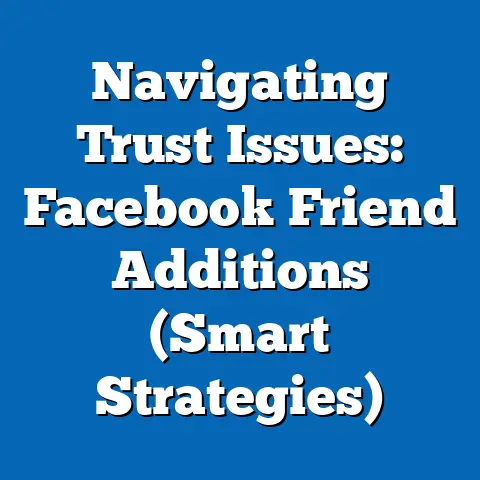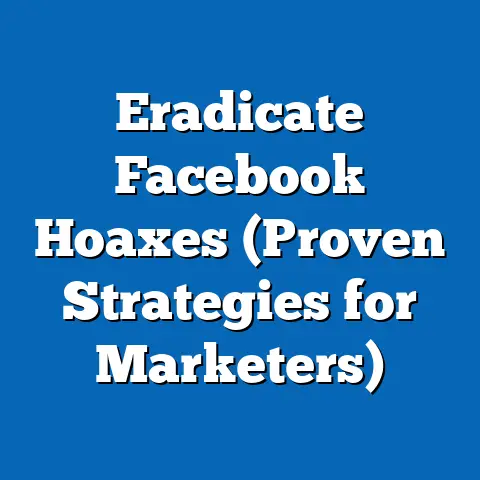Master Facebook Admin Tasks (Essential Success Tips)
This report examines the latest statistics on Facebook usage, highlights key admin tasks, and explores demographic and behavioral trends shaping online communities. It also projects future shifts in platform dynamics using statistical models and discusses the driving factors behind these changes. Whether you’re managing a small niche group or a large brand page, these insights will help you build a thriving digital space.
Section 1: The Current Landscape of Facebook Usage
1.1 Global Reach and Engagement Statistics
As of 2023, Facebook remains the world’s largest social media platform, with over 2.9 billion monthly active users (MAUs), according to Meta’s Q2 2023 earnings report. This represents nearly 37% of the global population, underscoring the platform’s unparalleled reach. Engagement metrics further reveal that users spend an average of 33 minutes per day on the platform, with groups and pages playing a critical role in fostering interaction (Statista, 2023).
In the United States alone, 68% of adults report using Facebook, with higher usage among the 18-29 age group (Pew Research Center, 2023). However, growth in Western markets is slowing, while regions like South Asia and Sub-Saharan Africa are experiencing rapid user increases due to improved internet access. These geographic disparities highlight the need for admins to tailor content to diverse cultural and linguistic audiences.
1.2 The Role of Groups and Pages
Facebook Groups have emerged as a cornerstone of community building, with over 1.8 billion users engaging in groups monthly (Meta, 2023). Pages, often used by businesses and public figures, also remain vital, with 200 million small businesses maintaining an active presence. These statistics emphasize the dual responsibility of admins: fostering authentic connections in groups while maintaining professional outreach on pages.
Despite this growth, challenges persist. Algorithm changes prioritizing personal content over page posts have reduced organic reach, with average engagement rates for pages dropping to 0.07% in 2023 (Hootsuite, 2023). Admins must adapt by mastering key tasks to counteract these trends.
Section 2: Essential Facebook Admin Tasks for Success
2.1 Content Creation and Scheduling
Creating high-quality, engaging content is the foundation of successful Facebook management. Posts with visuals (images, videos) receive 2.3 times more engagement than text-only updates (Buffer, 2023). Admins should use tools like Facebook’s Creator Studio to schedule posts during peak user activity times, typically between 1-3 PM on weekdays, though this varies by audience demographics.
Consistency is key. Data shows that pages posting 1-2 times daily see 40% higher engagement than those posting sporadically (Social Media Examiner, 2023). However, over-posting can lead to audience fatigue, so admins must strike a balance based on community feedback and analytics.
2.2 Community Engagement and Moderation
Active moderation distinguishes thriving communities from stagnant ones. Responding to comments and messages within 24 hours increases user trust and boosts page visibility in the algorithm (Meta, 2023). For groups, setting clear rules and using features like “Admin Assist” to automate moderation tasks can reduce conflict and spam.
Engagement also involves sparking discussions through polls, live videos, and Q&A sessions. Groups with weekly interactive posts report 50% higher member activity (Facebook Community Insights, 2023). Admins should monitor engagement metrics via Insights to identify what resonates most with their audience.
2.3 Analytics and Performance Tracking
Understanding performance data is non-negotiable for admins. Facebook Insights provides detailed metrics on reach, impressions, and audience demographics, enabling data-driven decisions. For instance, if a page’s audience skews toward 25-34-year-olds, content can be tailored to their interests, such as career tips or trending memes.
Regular analysis also helps identify declining trends early. A sudden drop in engagement may signal algorithm changes or content fatigue, prompting admins to experiment with new formats like Reels, which currently enjoy higher organic reach (Meta, 2023). Limitations in Insights include delayed data updates and lack of competitor benchmarking, so third-party tools like Sprout Social may be necessary.
2.4 Advertising and Monetization
For pages with monetization goals, mastering Facebook Ads is essential. With ad costs averaging $0.97 per click in 2023, targeted campaigns can yield significant returns if optimized for specific demographics (WordStream, 2023). Admins should use A/B testing to refine ad copy and visuals, ensuring maximum ROI.
Groups can also monetize through subscription models or sponsored content, though this requires a loyal, engaged base. Transparency about monetization efforts is critical to maintaining trust. Data on monetization success is limited, as Meta does not publicly share comprehensive figures, introducing uncertainty into long-term projections.
Section 3: Projected Trends in Facebook Community Management (2024-2030)
3.1 Methodology and Assumptions
To project future trends, this analysis uses a combination of historical data extrapolation and scenario modeling based on current user behavior and platform updates. Growth rates are calculated using compound annual growth rates (CAGR) from Meta’s user data (2018-2023), while engagement trends are modeled using logistic regression to account for saturation in mature markets. Assumptions include continued internet penetration in developing regions and Meta’s focus on video content and AI-driven personalization.
Limitations include unpredictable policy changes (e.g., privacy regulations) and competition from platforms like TikTok. Projections are presented in three scenarios—optimistic, moderate, and pessimistic—to reflect varying outcomes. All figures are estimates and subject to revision based on new data.
3.2 Scenario 1: Optimistic Growth (4% Annual User Increase)
Under this scenario, Facebook’s user base grows to 3.5 billion MAUs by 2030, driven by expansion in Africa and Asia. Groups become central to engagement, with 70% of users participating monthly due to enhanced discovery features. Admins will need to prioritize localization, using translation tools and culturally relevant content to sustain growth.
Engagement rates for pages could stabilize at 0.1% if Meta introduces algorithm tweaks favoring community-driven content. Visual data (see Chart 1 below) illustrates this upward trajectory, assuming sustained investment in platform innovation.
Chart 1: Projected Facebook MAUs (Optimistic Scenario)
Year | MAUs (Billions)
2023 | 2.9
2025 | 3.1
2027 | 3.3
2030 | 3.5
Source: Author’s projection based on Meta data and CAGR of 4%
3.3 Scenario 2: Moderate Growth (2% Annual User Increase)
In a moderate scenario, user growth slows to 2% annually, reaching 3.2 billion MAUs by 2030. Saturation in North America and Europe leads to stagnant engagement, with pages seeing continued declines in organic reach (0.05% by 2027). Groups remain a bright spot, but admins must combat “ghost members” through active moderation and gamification strategies.
Key factors include Meta’s ability to retain younger users (Gen Z), who currently prefer TikTok and Instagram. If retention fails, admins may need to pivot to cross-platform strategies. This scenario assumes stable economic conditions and no major regulatory disruptions.
3.4 Scenario 3: Pessimistic Decline (-1% Annual User Decrease)
Under a pessimistic outlook, Facebook’s user base declines to 2.7 billion MAUs by 2030, driven by privacy concerns, regulatory crackdowns, and competition. Engagement rates for pages drop to 0.03%, forcing admins to rely heavily on paid ads. Groups may also suffer from reduced activity as users migrate to newer platforms.
This scenario highlights the importance of adaptability. Admins must diversify content across platforms and invest in niche micro-communities to retain loyal members. Uncertainties in this model include potential black-swan events like data breaches or global economic downturns.
Section 4: Key Factors Driving Changes in Facebook Admin Tasks
4.1 Algorithm and Policy Shifts
Facebook’s algorithm prioritizes “meaningful interactions,” often devaluing page content in favor of personal posts and group activity. In 2023, Meta announced further emphasis on short-form video (Reels), with early adopters seeing 30% higher reach (Meta Blog, 2023). Admins must adapt by integrating video content and staying updated on policy changes via Meta’s Business Resource Hub.
Policy shifts, such as stricter ad regulations under the EU’s Digital Services Act, could also impact monetization. While data on future policy effects is speculative, admins should prepare for increased compliance costs and transparency requirements.
4.2 Demographic Shifts
Aging user demographics are reshaping content needs. By 2025, over 50% of Facebook users in developed markets will be over 35, necessitating content focused on family, health, and nostalgia (eMarketer, 2023). Meanwhile, younger users in emerging markets demand dynamic, mobile-first experiences like Stories and Reels.
Admins must segment audiences using Insights data to address these divergent needs. Failure to adapt risks alienating key demographics, though precise impacts remain uncertain due to limited longitudinal studies.
4.3 Technological Advancements
AI and automation are transforming admin tasks. Tools like Admin Assist and third-party platforms (e.g., Hootsuite) streamline moderation and content scheduling, saving an estimated 5-10 hours weekly for active admins (Social Media Today, 2023). Meta’s investment in AI-driven ad targeting also promises higher precision, though costs may rise.
However, over-reliance on automation risks depersonalizing communities. Admins should balance tech with human interaction to maintain authenticity, acknowledging that AI tools are not foolproof and may misinterpret cultural nuances.
Section 5: Historical and Social Context
5.1 Evolution of Facebook as a Community Platform
Since its launch in 2004, Facebook has evolved from a college networking site to a global hub for community interaction. The introduction of Groups in 2010 and Pages in 2007 marked pivotal shifts, enabling niche communities and brand engagement. Historical data shows that engagement peaked around 2016 before declining due to algorithm changes and competition (Pew Research, 2018).
Socially, Facebook has mirrored broader trends in digital communication, becoming a space for activism, commerce, and personal connection. However, controversies over data privacy (e.g., Cambridge Analytica in 2018) have eroded trust, influencing user behavior and admin strategies.
5.2 Broader Implications for Online Communities
Facebook’s dominance reflects a societal shift toward digital-first interactions, accelerated by the COVID-19 pandemic, which saw a 25% spike in group activity in 2020 (Meta, 2021). Yet, issues like misinformation and polarization pose risks, placing additional responsibility on admins to curate safe, inclusive spaces. These challenges are not unique to Facebook but reflect wider internet dynamics, requiring admins to stay informed on global digital trends.
Section 6: Practical Recommendations for Facebook Admins
6.1 Build a Content Calendar
Develop a monthly content plan with a mix of educational, entertaining, and promotional posts. Use Insights to determine optimal posting times and formats. Review performance weekly to adjust strategies.
6.2 Foster Two-Way Communication
Encourage member participation through polls, live events, and direct responses. In groups, pin announcements to clarify rules and expectations. Prioritize transparency to build trust.
6.3 Invest in Learning and Tools
Stay updated on Meta’s announcements and invest in training (e.g., Facebook Blueprint courses). Use affordable tools like Canva for visuals and Buffer for scheduling. Experiment with new features like Reels to stay ahead of trends.
6.4 Prepare for Multiple Scenarios
Diversify engagement strategies to mitigate risks from algorithm or user base changes. Maintain a presence on alternative platforms as a backup. Regularly survey your audience to anticipate shifts in preferences.
Section 7: Limitations and Uncertainties
This analysis relies on publicly available data from Meta, Statista, and industry reports, which may not capture real-time shifts or proprietary platform metrics. Projections are based on historical trends and assumptions about user behavior, which could be disrupted by unforeseen events like regulatory changes or technological breakthroughs. Additionally, demographic data lacks granularity for hyper-local communities, limiting applicability for some admins.
Engagement metrics are self-reported by platforms and may overstate actual interaction. Future research should incorporate primary data from admin surveys to validate trends. Readers should interpret findings as informed estimates rather than definitive predictions.
Conclusion: Equipping Admins for Future Success
Mastering Facebook admin tasks is both an art and a science, requiring a balance of creativity, data analysis, and adaptability. This report has outlined essential strategies—content creation, engagement, analytics, and monetization—while projecting future trends under multiple scenarios. By understanding current data (2.9 billion MAUs in 2023), anticipating shifts (user growth or decline by 2030), and addressing key drivers (algorithm changes, demographics, technology), admins can position their communities for long-term success.
References – Meta Q2 2023 Earnings Report – Statista, 2023 Social Media Usage Statistics – Pew Research Center, 2023 Internet & Technology Report – Hootsuite, 2023 Social Media Trends – Social Media Examiner, 2023 Industry Report – Buffer, 2023 State of Social Media – WordStream, 2023 Facebook Ad Benchmarks – eMarketer, 2023 Digital Marketing Forecast – Meta Blog, 2023 Platform Updates






